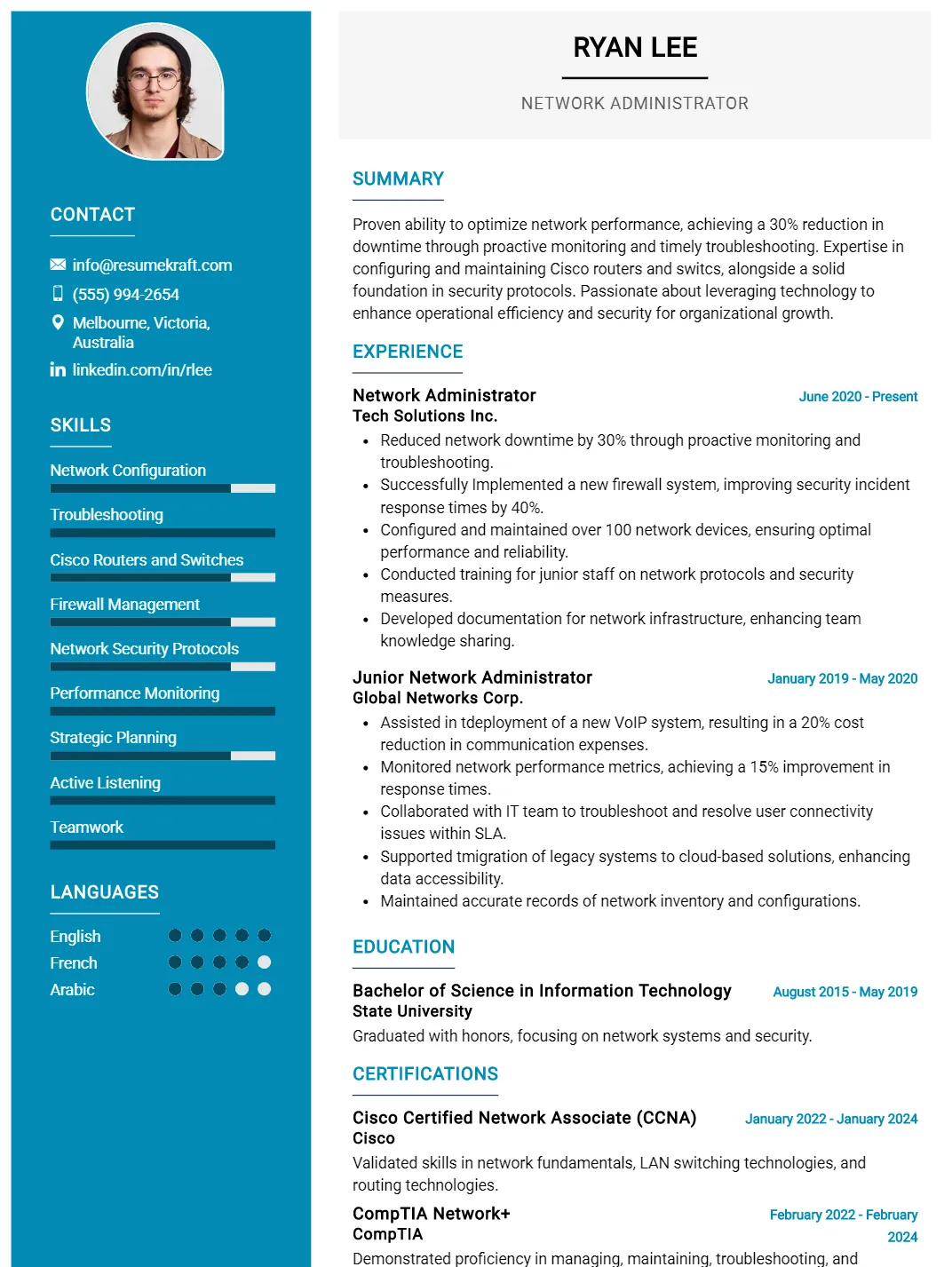
The role of a Network Administrator is crucial in today’s increasingly digital landscape, where seamless connectivity and robust network security are paramount. These professionals are responsible for managing, maintaining, and securing an organization’s network infrastructure, ensuring that data flows efficiently and securely. As businesses become more reliant on technology, the demand for skilled Network Administrators continues to rise, making it a promising career choice. This article will guide you through the essential components of crafting a compelling resume for a Network Administrator position, highlighting key skills and examples to help you stand out in the competitive job market.
- Network Administrator resume examples
- How to format a Network Administrator resume
- How to write your Network Administrator resume experience
- How to list your hard skills and soft skills on your resume
- How to list your certifications and education on your resume
- How to write your Network Administrator resume summary or objective
- Additional sections for a Network Administrator resume
- Key takeaways for writing a professional Network Administrator resume
- Frequently Asked Questions
Network Administrator resume examples
Network Administrator resume examples serve as valuable resources for job seekers aiming to secure positions in this technical field. By examining these examples, candidates can grasp the essential components of an effective resume, such as highlighting relevant skills, certifications, and accomplishments. This understanding enables them to tailor their applications, showcasing their expertise in managing networks and troubleshooting issues, ultimately increasing their chances of landing interviews.
Network Administrator Resume

Why This Resume Works
This resume effectively highlights the candidate’s six years of experience in network administration, showcasing key skills such as network configuration and troubleshooting, which are crucial for the role. Its structured format allows for easy readability, making it ATS-compatible by incorporating relevant keywords like Cisco routers and firewall management. Additionally, the strategic presentation of achievements demonstrates a proven track record in enhancing network security and performance, aligning perfectly with the expectations of employers seeking an adept Network Administrator.
Systems Network Administrator Resume

Why This Resume Works
This resume effectively highlights the candidate’s relevant skills and experience for a Systems Network Administrator position, showcasing expertise in Cisco Routing and Switching, Windows Server Administration, and Network Security. The clear structure facilitates quick scanning, ideal for hiring managers. Additionally, its use of industry-specific keywords enhances ATS compatibility, ensuring that it passes initial screenings. Strategic presentation of achievements emphasizes problem-solving abilities and successful project implementations, making it compelling to potential employers seeking a well-rounded professional in network administration.
Network Systems Engineer Resume
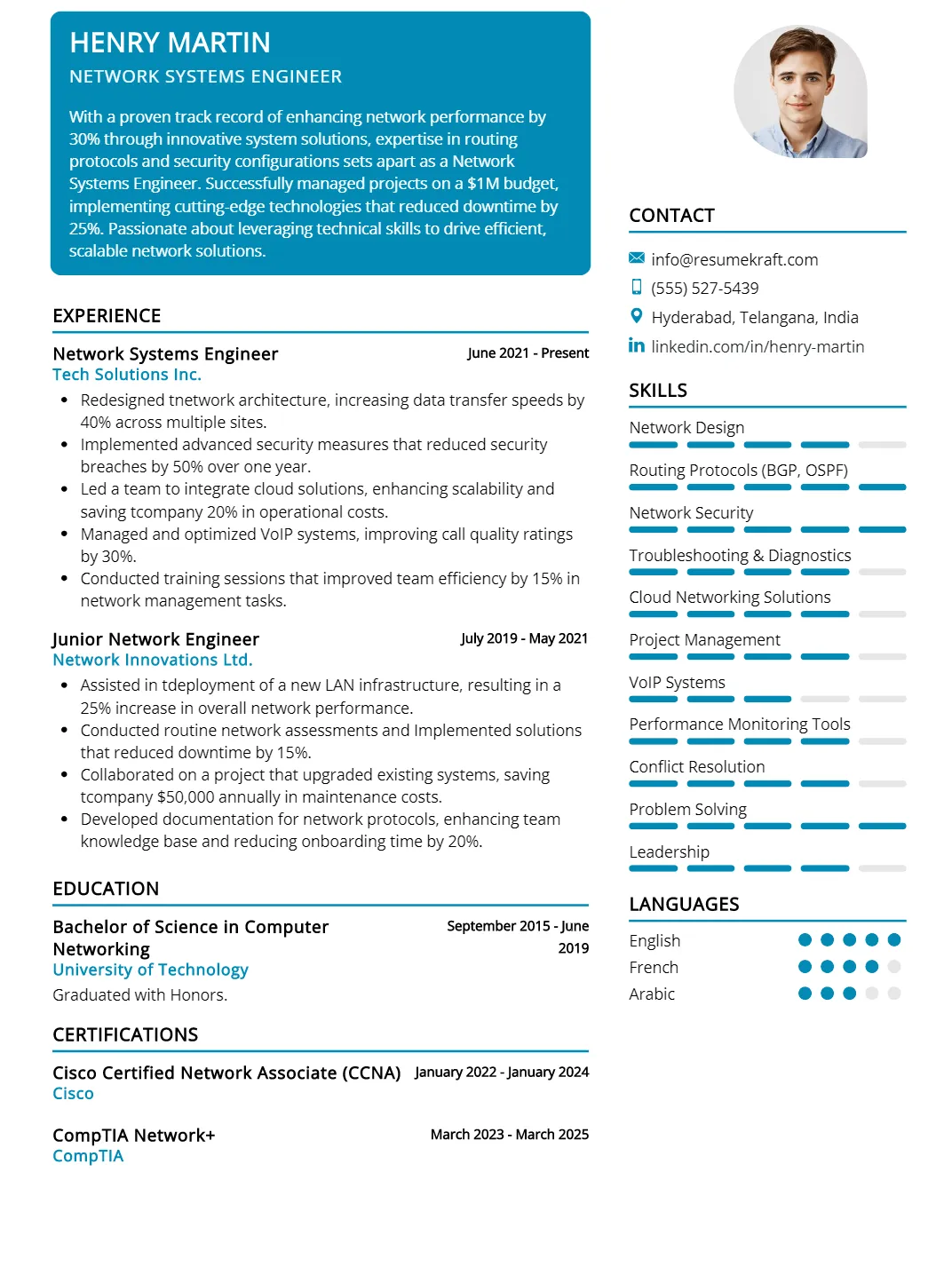
Why This Resume Works
This resume effectively highlights relevant skills such as Network Design, Routing Protocols (BGP, OSPF), and Network Security, directly aligning with the requirements of a Network Systems Engineer. With approximately six years of experience in progressively responsible roles, it showcases a solid professional foundation. The clear format enhances readability and emphasizes key competencies, making it ATS-compatible. Additionally, strategic presentation of achievements related to troubleshooting and cloud networking solutions demonstrates the candidate’s impact in previous roles, reinforcing their suitability for this position.
Network Administrator with Cybersecurity Specialization Resume
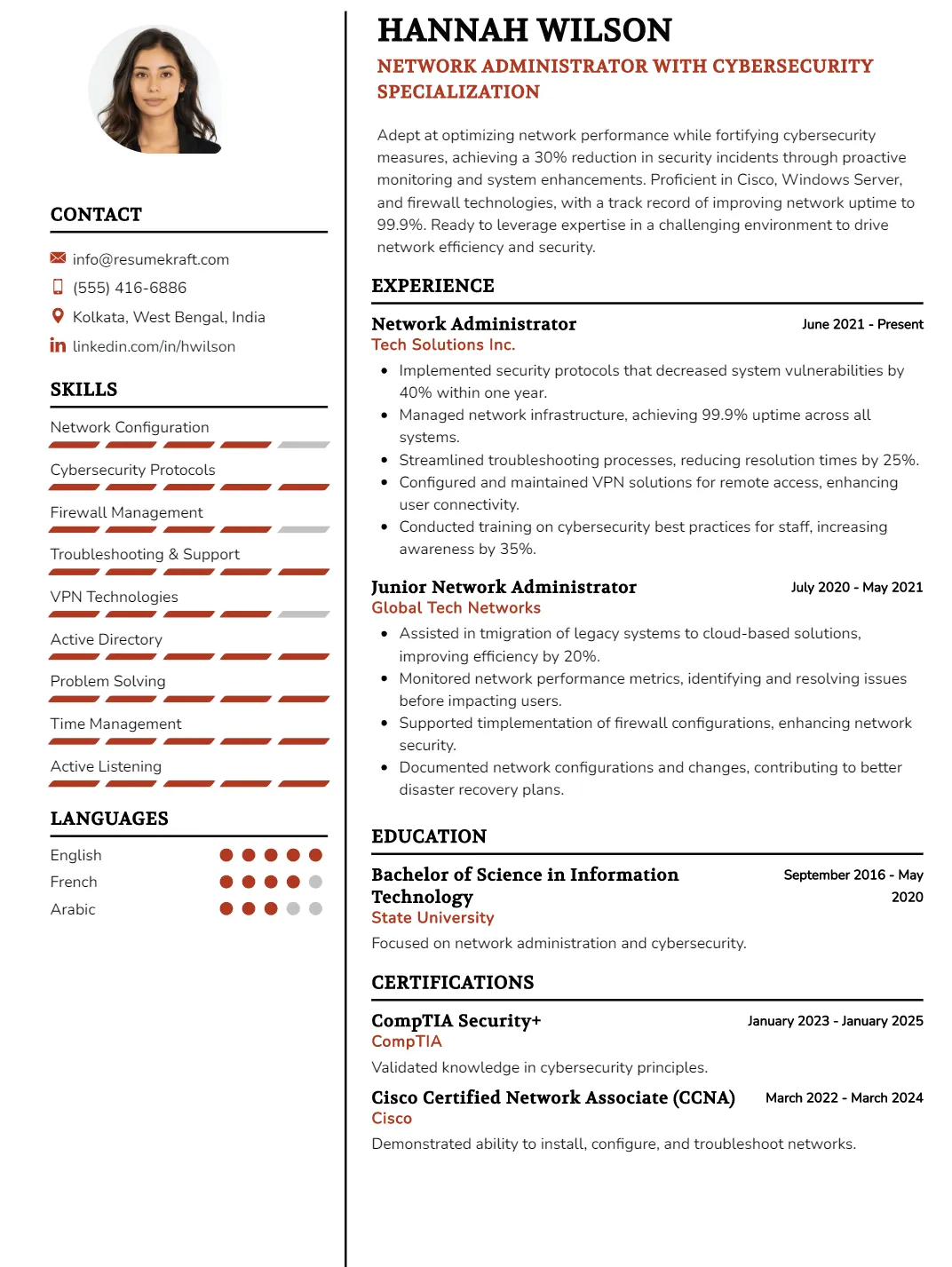
Why This Resume Works
This resume effectively highlights the candidate’s key skills in network configuration and cybersecurity protocols, directly aligning with the requirements for a Network Administrator with Cybersecurity Specialization. Its clear structure enhances readability, showcasing relevant experience as a Network Administrator and Junior Network Administrator over five years. By utilizing industry-specific keywords, it ensures ATS compatibility, increasing visibility to hiring managers. Additionally, strategically presented achievements emphasize the candidate’s success in firewall management and VPN technologies, making it compelling for this specialized position.
Junior Network Administrator Resume
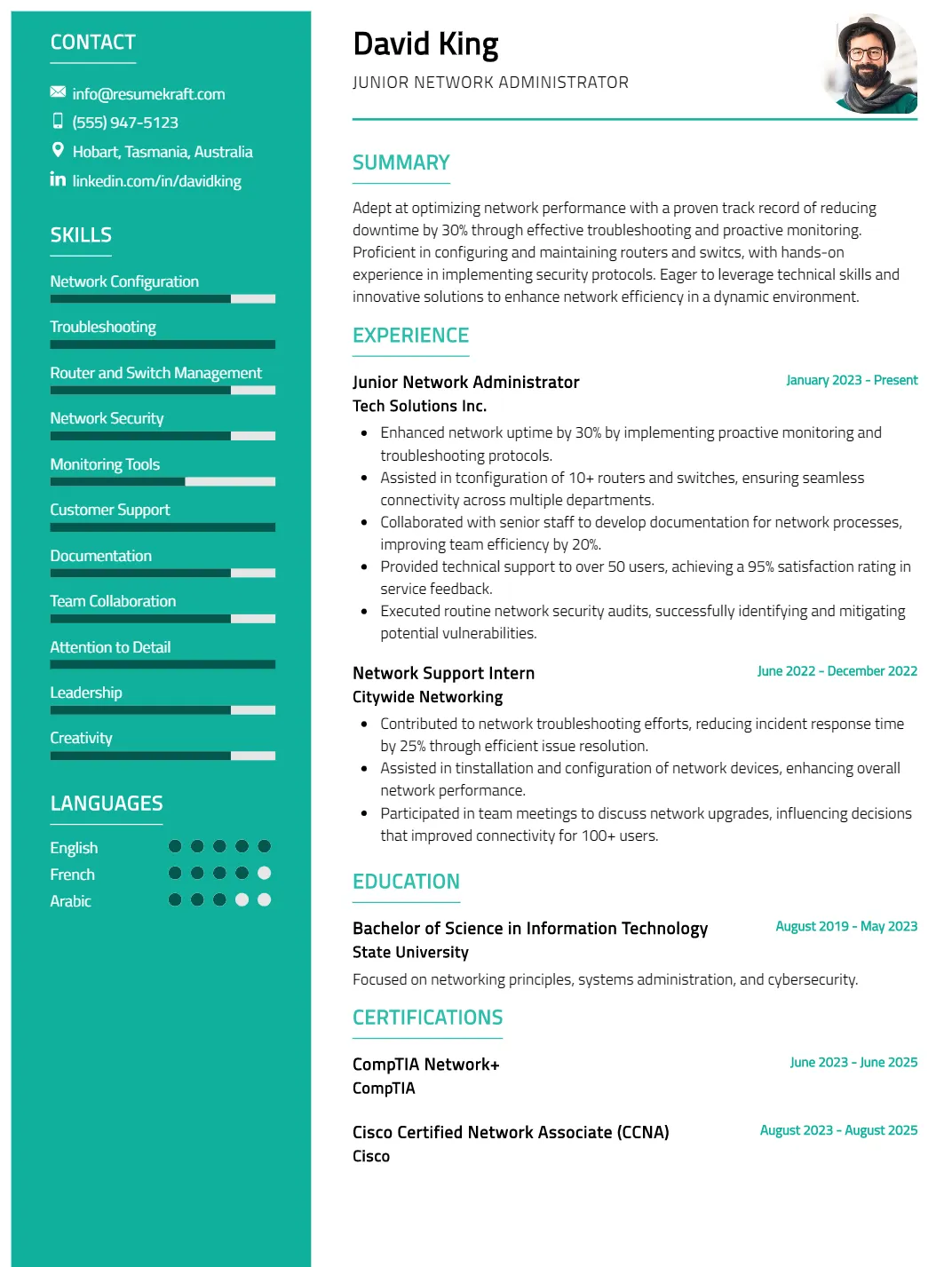
Why This Resume Works
This resume effectively highlights the candidate’s relevant skills, such as network configuration and troubleshooting, essential for a Junior Network Administrator role. The two years of experience, including a dedicated internship, demonstrate practical knowledge in router and switch management. The clear format and structured layout enhance readability, making it ATS-compatible by incorporating industry-specific keywords. Additionally, the strategic presentation of achievements related to network security and monitoring tools underscores the candidate’s capability to contribute meaningfully in this field, making them an attractive hire.
Lead Network Technician Resume
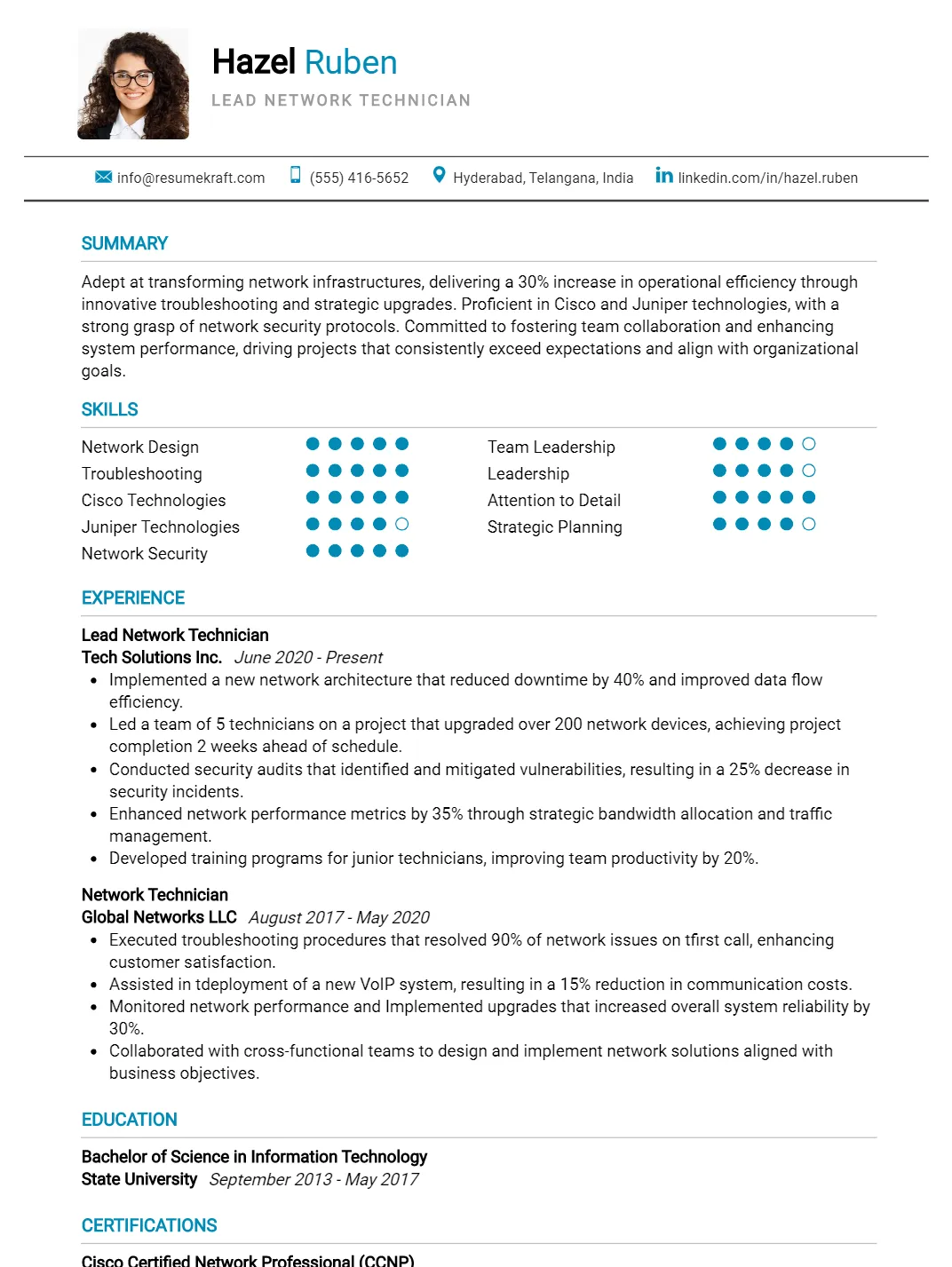
Why This Resume Works
This resume effectively highlights the candidate’s extensive experience as a Lead Network Technician, showcasing key skills in network design, troubleshooting, and expertise with Cisco and Juniper technologies. The structured format emphasizes relevant achievements, ensuring clarity and quick comprehension for hiring managers. It is tailored for ATS compatibility by incorporating industry-specific keywords like “network security,” enhancing visibility during the application process. Overall, this strategic presentation of qualifications aligns perfectly with the demands of a Lead Network Technician position, making it stand out among peers.
IT Infrastructure Consultant with Network Administration Focus Resume
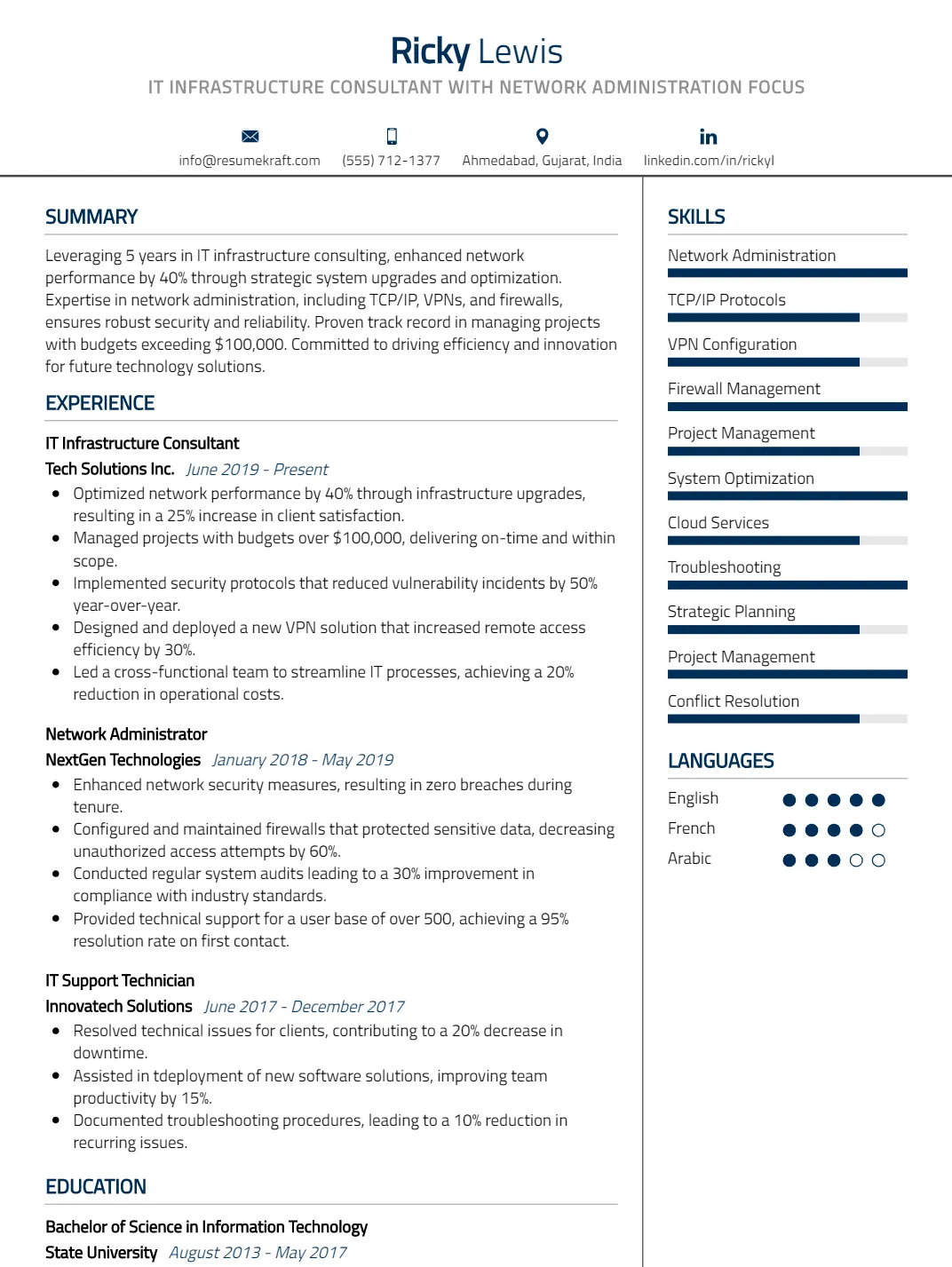
Why This Resume Works
This resume effectively highlights the candidate’s relevant skills and experience for the IT Infrastructure Consultant with Network Administration Focus position. Key skills like Network Administration and Firewall Management align perfectly with industry requirements, while seven years of progressive experience ensures credibility. The structured format enhances readability, making it ATS-friendly by incorporating keywords pertinent to the role. Additionally, strategic presentation of achievements showcases successful project management and technical implementation, demonstrating the candidate’s capability to deliver value in this specialized field.
Senior Network Infrastructure Architect Resume
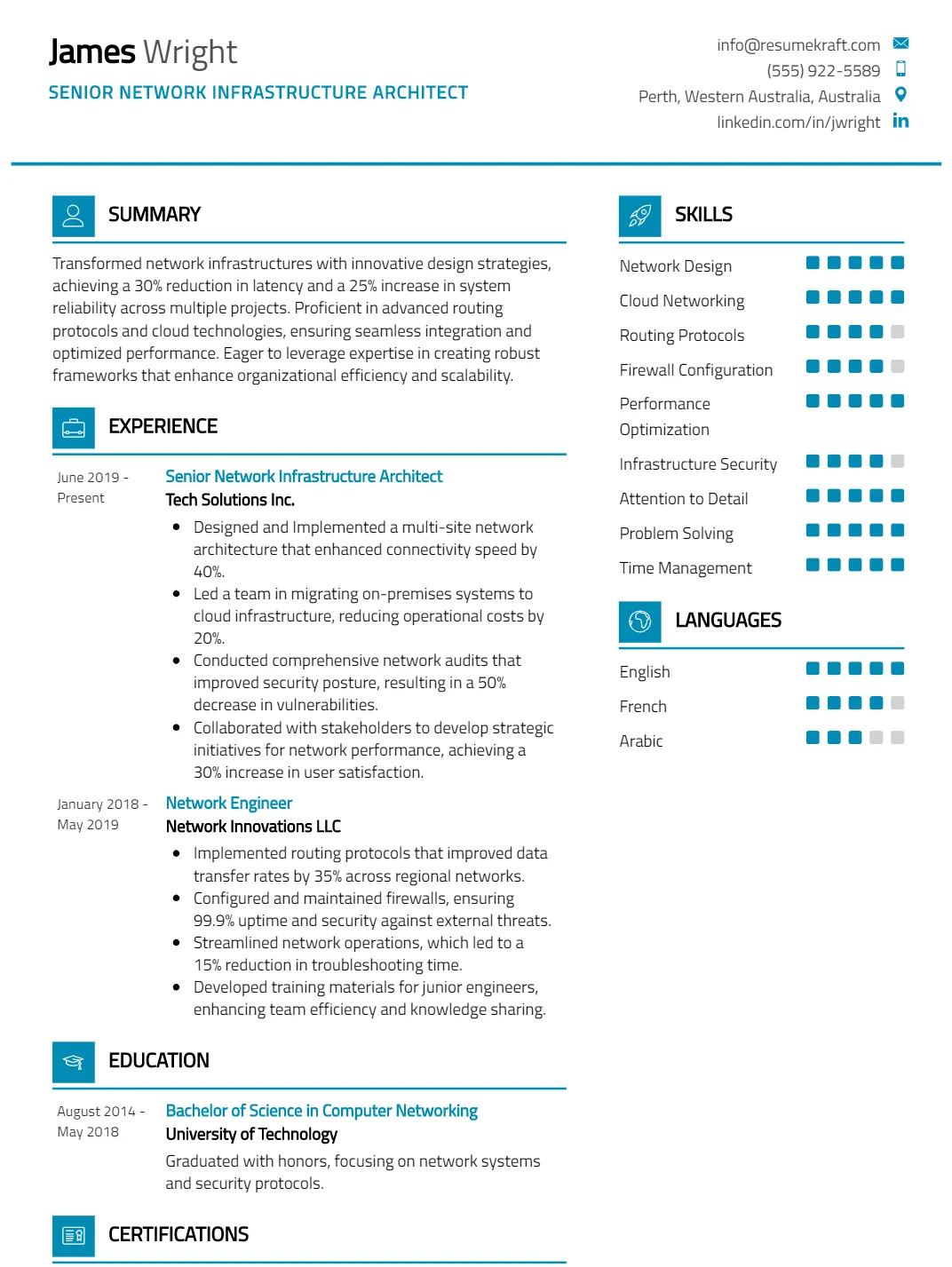
Why This Resume Works
This resume effectively highlights the candidate’s expertise in key areas such as network design and cloud networking, essential for a Senior Network Infrastructure Architect role. With approximately seven years of relevant experience, it demonstrates a progressive career path that aligns well with industry demands. The format is clean and structured, facilitating easy navigation for hiring managers. Additionally, the inclusion of targeted keywords ensures ATS compatibility. Strategic presentation of achievements showcases measurable impacts in performance optimization and firewall configuration, reinforcing the candidate’s qualifications for this position.
IT Network Manager Resume
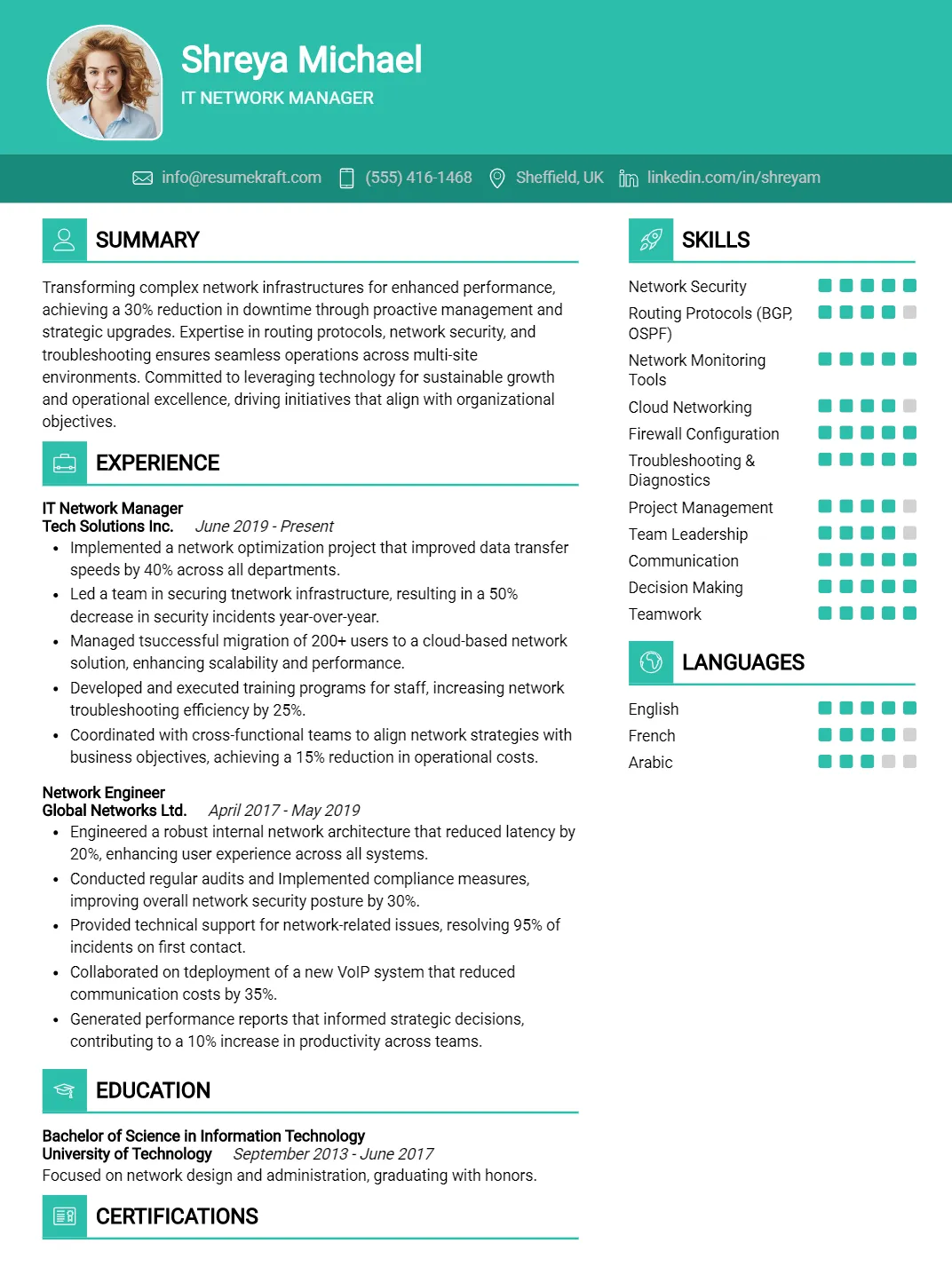
Why This Resume Works
This resume effectively positions the candidate for the IT Network Manager role by highlighting essential skills such as network security and proficiency in routing protocols like BGP and OSPF. With eight years of relevant experience, it demonstrates a strong background in both management and engineering. The structured format ensures clarity, enhancing ATS compatibility with strategic keyword usage. Additionally, presenting quantifiable achievements related to network optimization and security reinforces the candidate’s capability to drive success in this critical field.
Senior Network Operations Manager Resume
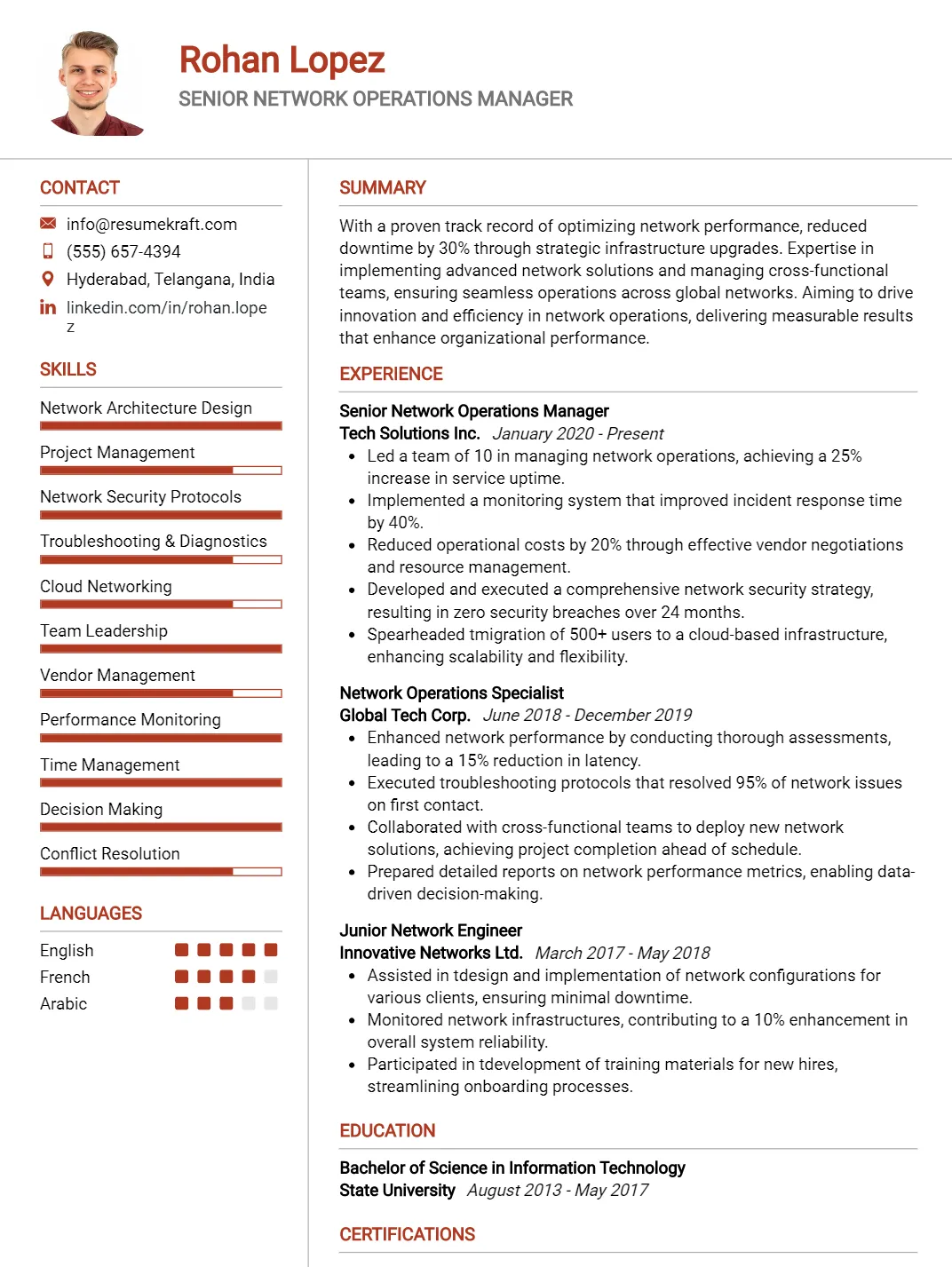
Why This Resume Works
This resume effectively positions the candidate for a Senior Network Operations Manager role by highlighting essential skills such as Network Architecture Design and Project Management, which are crucial for leadership in network operations. The structured format enhances readability and allows key qualifications to stand out immediately. By incorporating industry-specific keywords, it ensures ATS compatibility, increasing visibility to recruiters. Additionally, the strategic presentation of achievements showcases measurable successes in past roles, demonstrating the candidate’s capacity to drive results in network management.
Network Configuration Specialist Resume
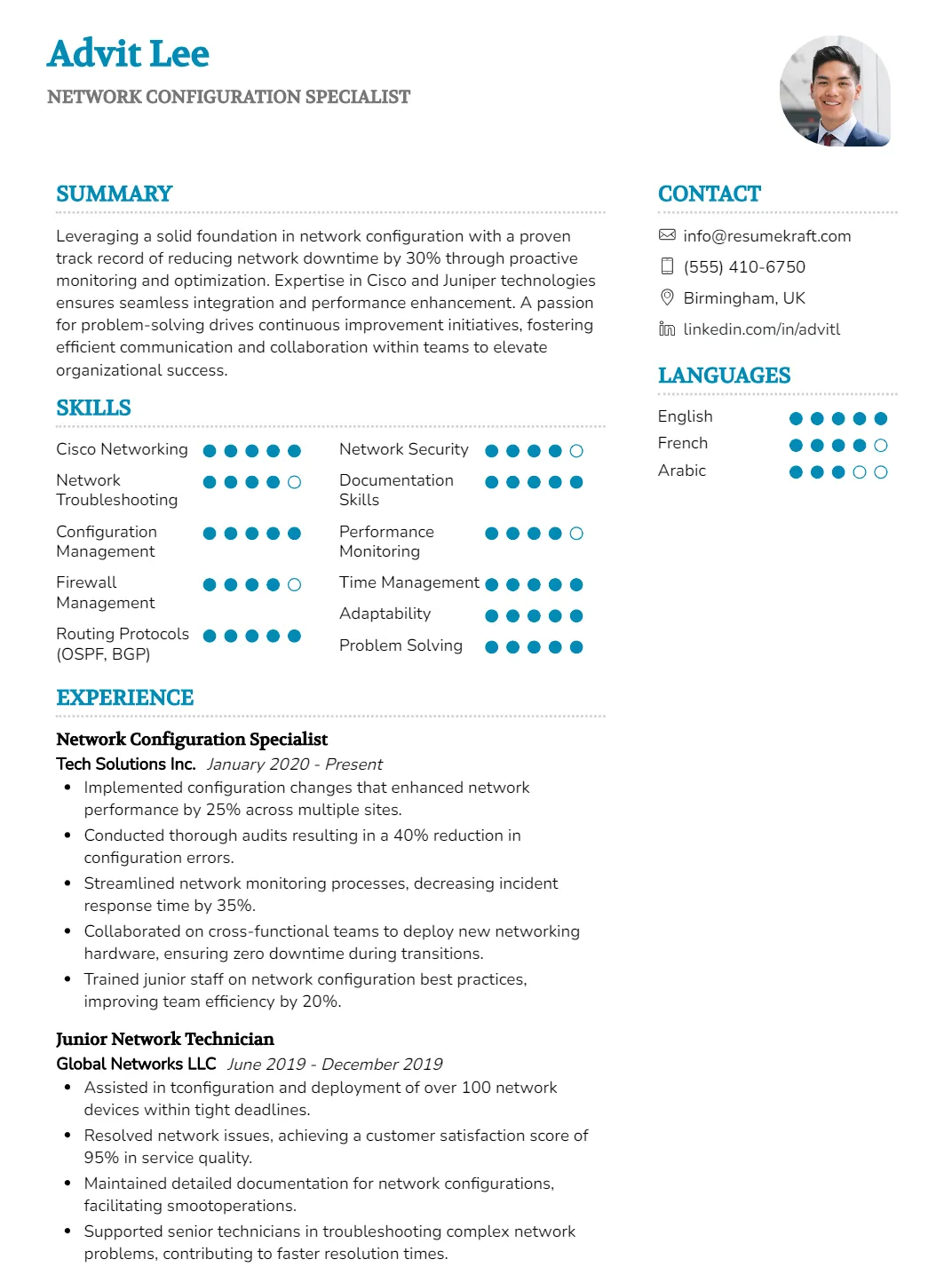
Why This Resume Works
This resume effectively highlights the candidate’s relevant skills and experience for a Network Configuration Specialist position. With expertise in Cisco Networking, troubleshooting, and configuration management, it directly aligns with job requirements. The clear format and structured layout enhance readability, essential for busy recruiters. ATS compatibility is ensured through the strategic use of industry-specific keywords like OSPF and BGP. Additionally, showcasing achievements in firewall management and network optimization demonstrates the candidate’s impact and readiness to excel in this role.
Network Infrastructure Security Analyst Resume
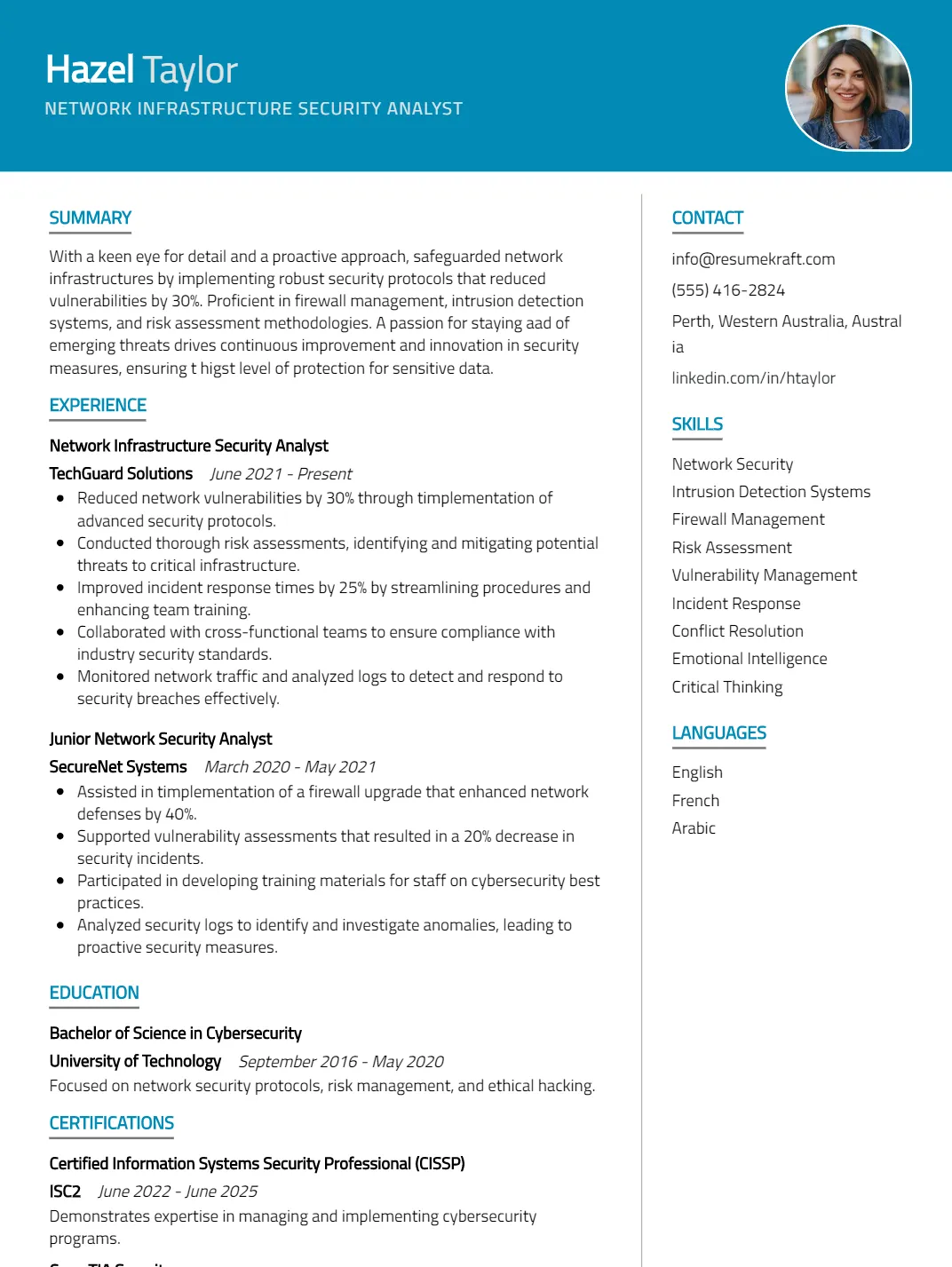
Why This Resume Works
This resume effectively highlights the candidate’s qualifications for a Network Infrastructure Security Analyst position by aligning key skills such as Network Security and Intrusion Detection Systems with relevant experience spanning five years. The structured format enhances readability, ensuring critical information is easily accessible. Additionally, the use of industry-specific keywords boosts ATS compatibility, increasing visibility to recruiters. Strategic presentation of achievements related to Firewall Management and Risk Assessment underscores the candidate’s impact in previous roles, making them a compelling choice for potential employers.
Network Infrastructure Engineer Resume

Why This Resume Works
This resume effectively highlights the candidate’s relevant skills, such as Cisco Routing & Switching and Network Security, directly aligning with the requirements of a Network Infrastructure Engineer. With approximately six years of experience, it demonstrates a clear career progression from Junior Network Engineer. The structured format enhances readability, while keyword optimization ensures ATS compatibility. Additionally, strategic presentation of achievements showcases problem-solving capabilities and proficiency in network monitoring tools, making this resume particularly compelling for potential employers in the network infrastructure domain.
Network Infrastructure Project Manager Resume
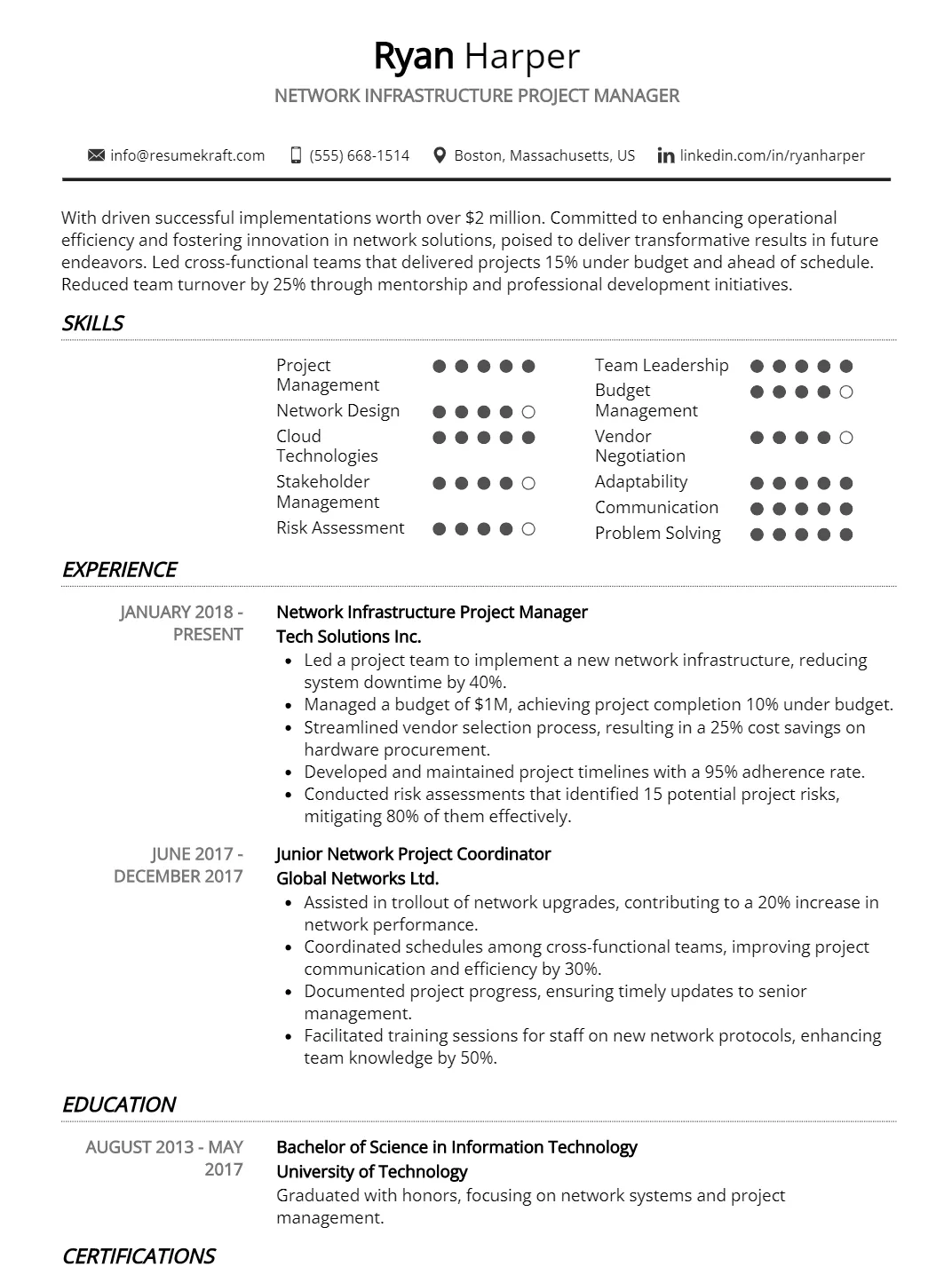
Why This Resume Works
This resume effectively showcases the candidate’s suitability for a Network Infrastructure Project Manager position through a clear emphasis on relevant skills like Project Management and Network Design, supported by seven years of progressive experience. The structured format highlights key competencies, enhancing readability for hiring managers. Its ATS-friendly design incorporates industry-specific keywords, ensuring compatibility with automated screening systems. Additionally, strategically presented achievements demonstrate measurable impacts in past roles, underscoring the candidate’s ability to drive successful network projects and manage stakeholder expectations effectively.
Cloud Network Operations Specialist Resume
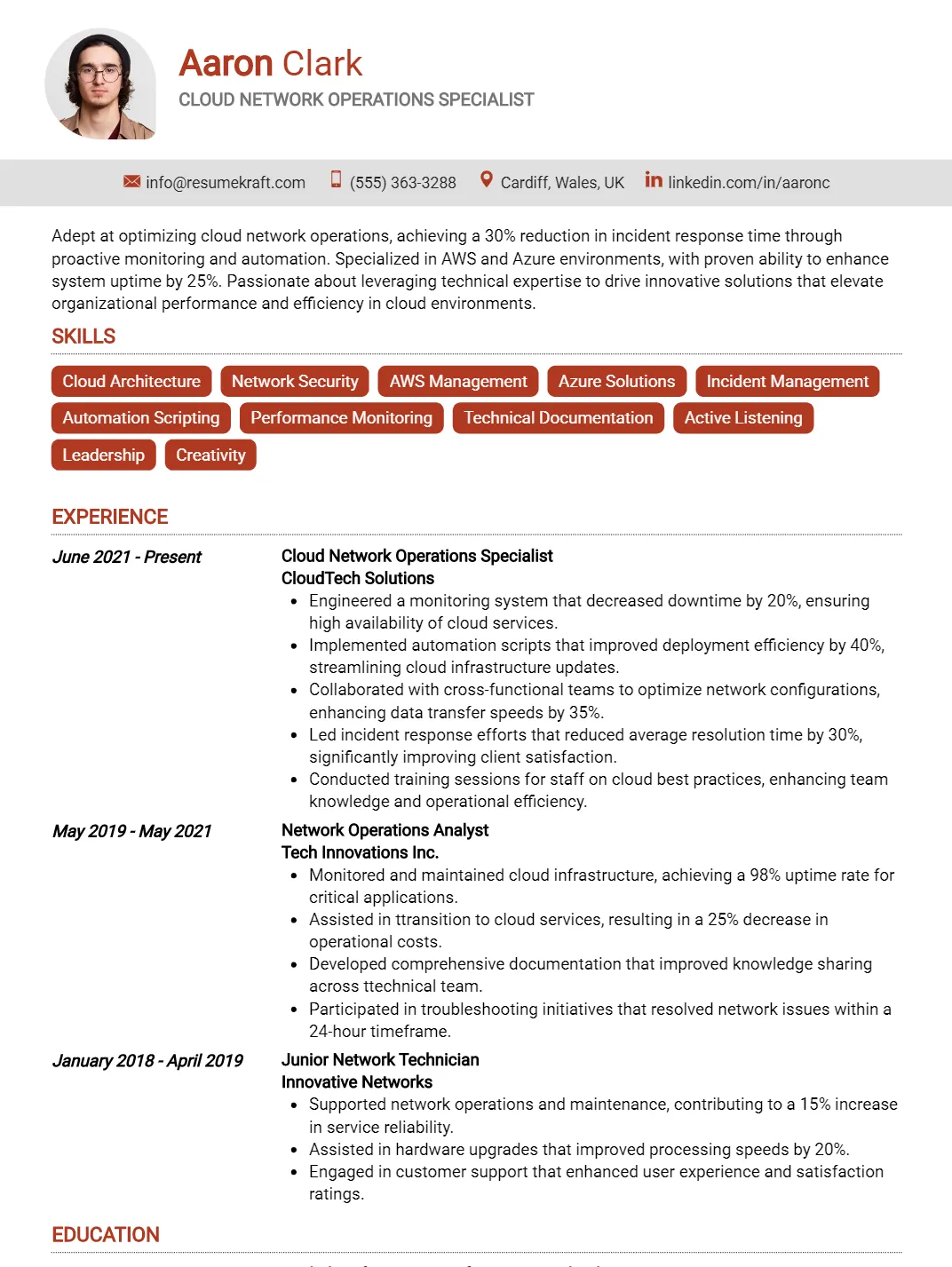
Why This Resume Works
This resume effectively highlights the candidate’s relevant skills in Cloud Architecture, Network Security, and AWS Management, directly aligning with the requirements of a Cloud Network Operations Specialist. With approximately seven years of progressive experience—from Junior Network Technician to Cloud Network Operations Specialist—it demonstrates a solid career trajectory. The structured format enhances readability for hiring managers and ensures ATS compatibility through targeted keywords. Additionally, strategic presentation of achievements showcases impactful contributions in incident management and cloud solutions, making it compelling for this role.
Chief Network Officer Resume
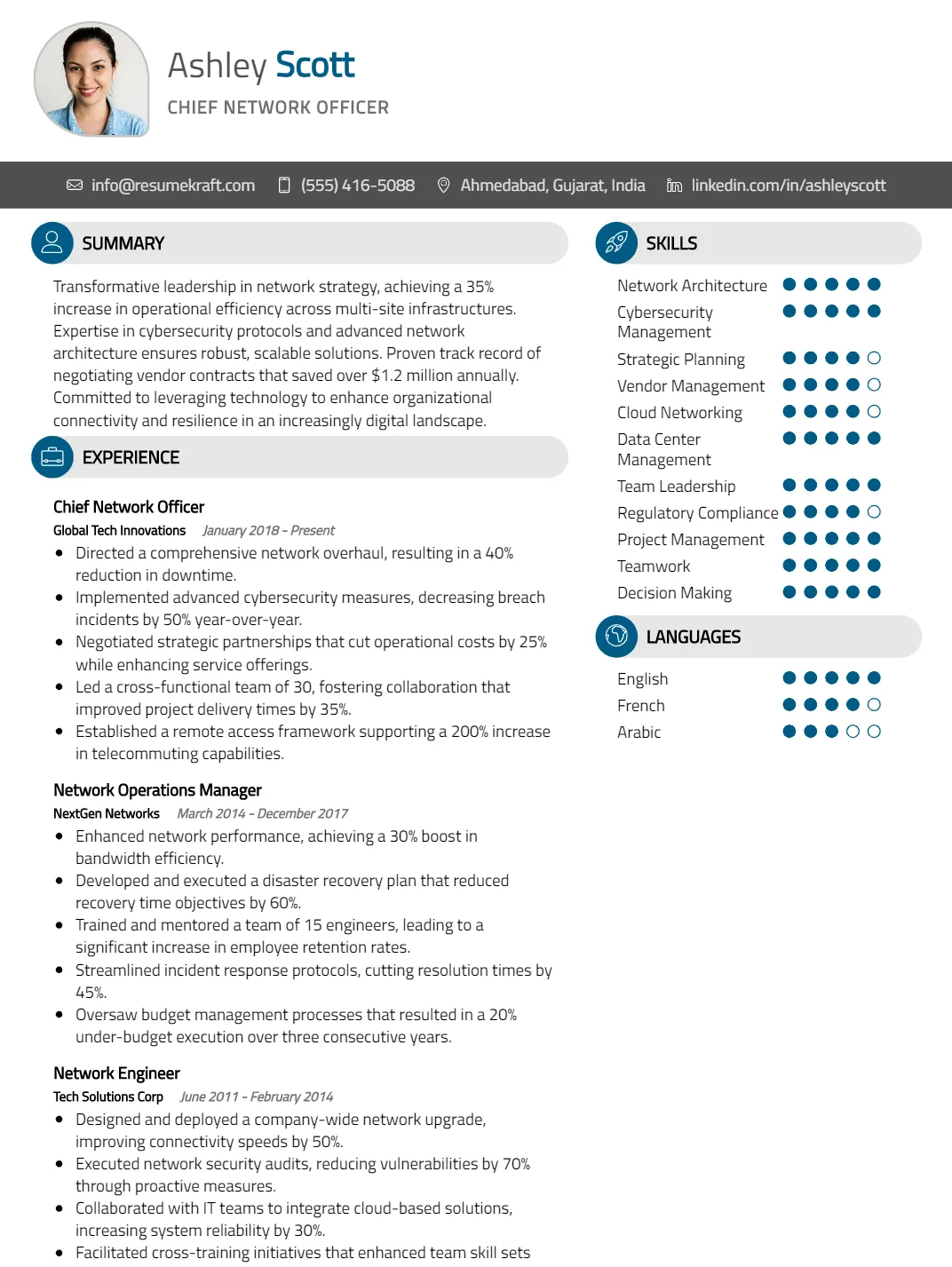
Why This Resume Works
This resume effectively positions the candidate for the Chief Network Officer role by showcasing a robust skill set in network architecture, cybersecurity management, and strategic planning, all critical for this position. The structured format highlights relevant experience spanning 13 years, including leadership roles that demonstrate expertise in vendor and cloud networking management. Its use of industry-specific keywords enhances ATS compatibility, while strategically presented achievements underscore the candidate’s impact on network efficiency and security, aligning perfectly with the expectations of prospective employers in this field.
Network Virtualization Specialist Resume
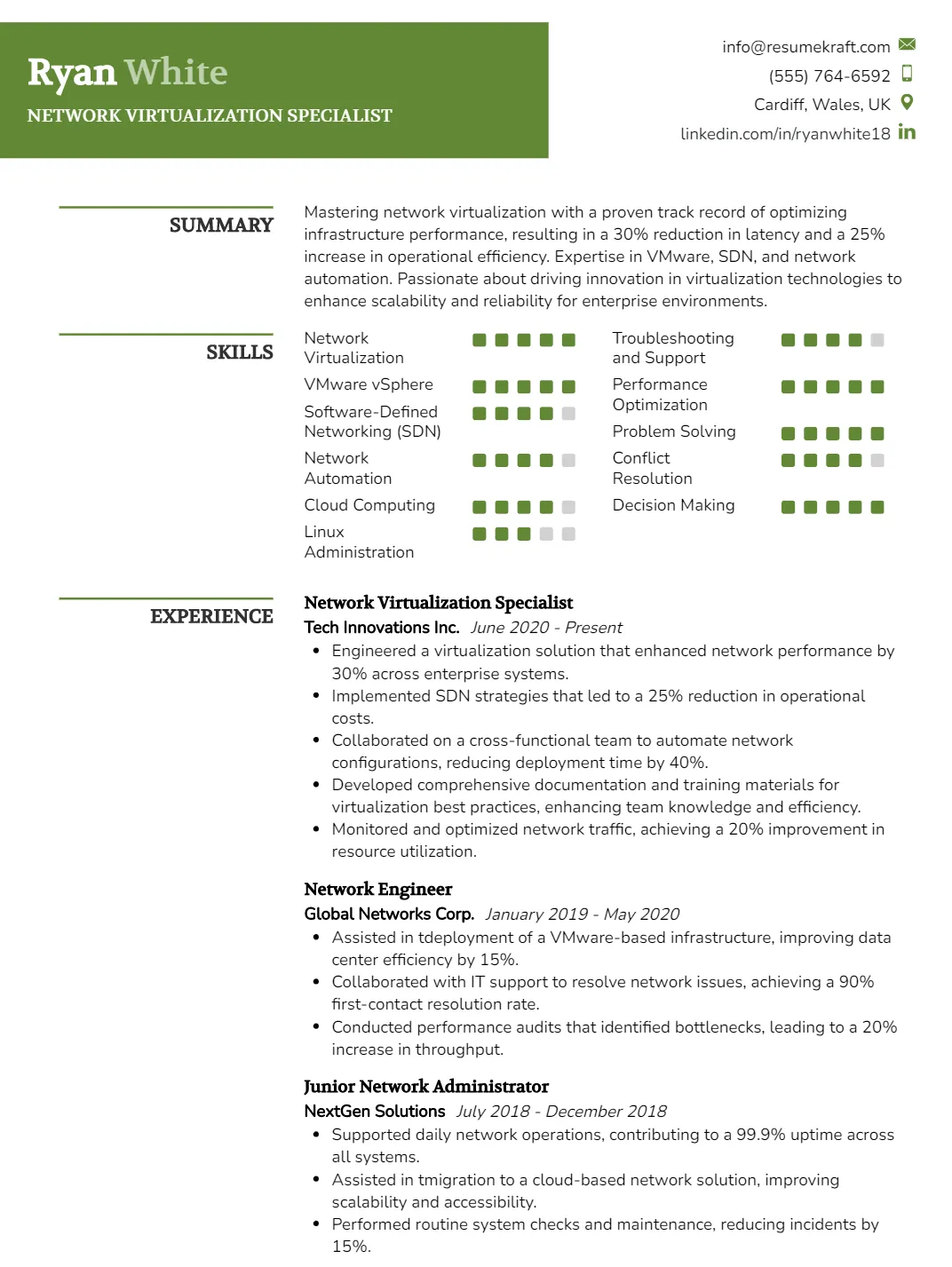
Why This Resume Works
This resume effectively highlights the candidate’s skills in Network Virtualization, VMware vSphere, and Software-Defined Networking, directly aligning with the requirements of a Network Virtualization Specialist. The structured format clearly showcases approximately six years of relevant experience, enhancing readability for hiring managers. Additionally, its use of industry-specific keywords ensures compatibility with Applicant Tracking Systems (ATS). Strategic presentation of achievements demonstrates tangible contributions to previous roles, reinforcing the candidate’s value in optimizing network performance and automation within cloud environments.
Enterprise Network Solutions Architect Resume
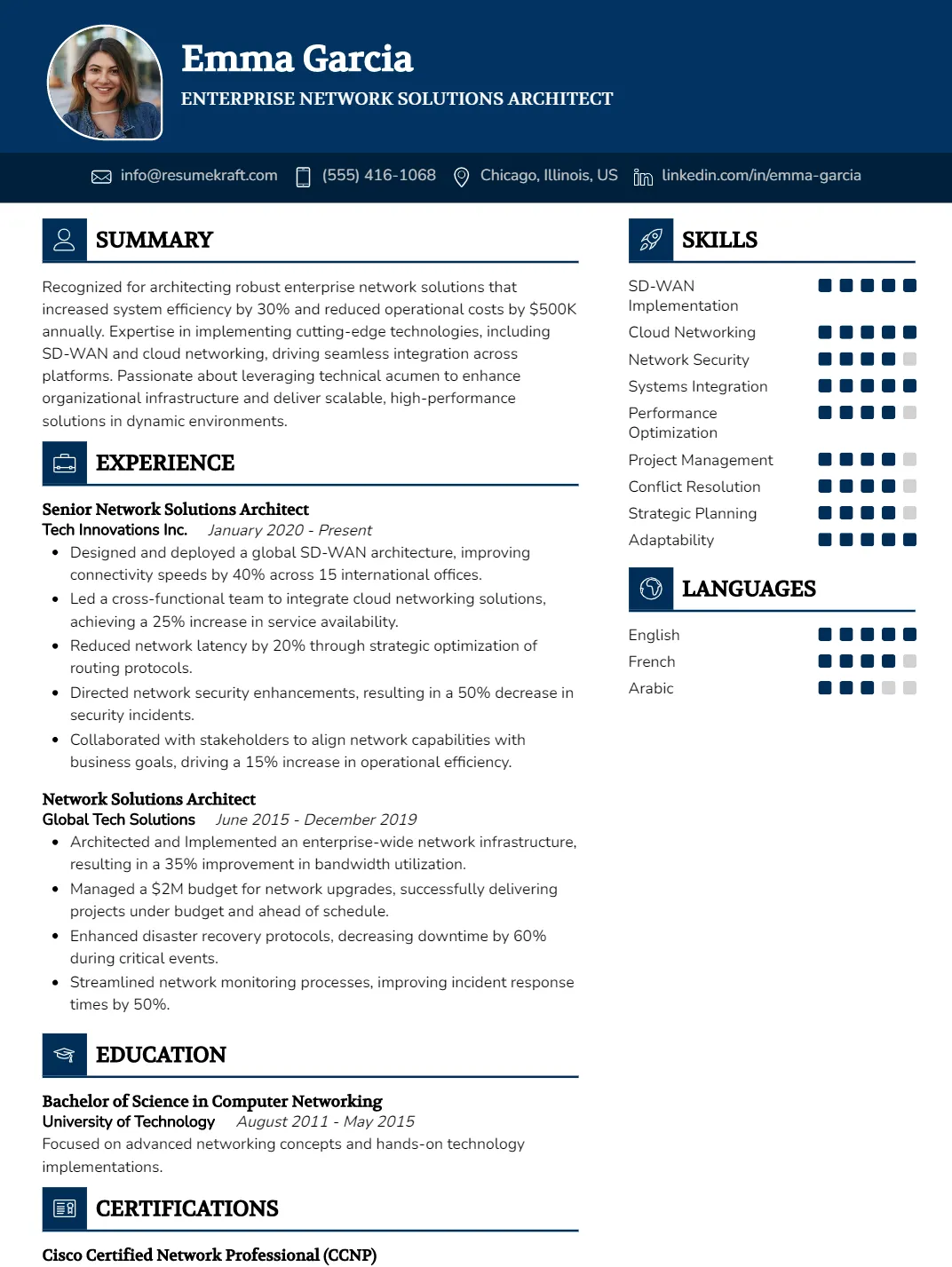
Why This Resume Works
This resume effectively highlights the candidate’s extensive experience as a Senior Network Solutions Architect, underscoring their expertise in critical skills like SD-WAN implementation and network security. The structured format presents key competencies clearly, appealing to hiring managers. Its ATS-friendly design ensures visibility through relevant keywords, enhancing compatibility with industry standards. Additionally, the strategic focus on achievements related to performance optimization and systems integration showcases measurable contributions, making it compelling for an Enterprise Network Solutions Architect role.
How to format a Network Administrator resume
Proper formatting is crucial for a Network Administrator resume as it enhances readability and allows hiring managers to quickly identify key qualifications and experiences. An effective resume format can significantly impact your chances of landing an interview in this competitive field.
- Use a clean, professional layout that includes clear headings and bullet points, making it easy for recruiters to scan your skills and experience quickly.
- Prioritize your technical skills section by placing it near the top, ensuring that essential qualifications like networking protocols and system administration tools are immediately visible.
- Limit your resume to one or two pages; this allows you to present relevant information concisely without overwhelming the reader with unnecessary details.
- Choose a legible font such as Arial or Calibri, and maintain a font size between 10-12 points to ensure your text is easy to read across various devices.
- Include consistent formatting for dates and job titles, aligning them uniformly throughout the document to create a cohesive and professional appearance that reflects your attention to detail.
How to write your Network Administrator resume experience
Effectively presenting work experience on a Network Administrator resume is essential, as it showcases your technical abilities and problem-solving skills to potential employers. This section is crucial because it provides insight into your hands-on experience with network systems, troubleshooting, and security protocols, which are vital for the role.
Employers typically seek candidates with a proven track record of managing network infrastructure, implementing solutions, and optimizing performance. Highlighting specific achievements, technologies used, and the impact of your contributions can significantly enhance your appeal as a candidate.
Worked at a company maintaining networks and fixing issues. Responsible for ensuring everything was running smoothly.
Administered a network of 500+ devices, reducing downtime by 30% through proactive monitoring and troubleshooting, and upgraded firewalls to enhance security compliance by 40%.
How to list your hard skills and soft skills on your resume
In the competitive field of network administration, showcasing both hard and soft skills on your resume is crucial for standing out to potential employers. Hard skills demonstrate your technical expertise and ability to manage network systems, while soft skills highlight your interpersonal abilities and problem-solving capabilities. A well-rounded resume that balances these two skill types can effectively convey your qualifications and readiness for the demands of the role.
Hard Skills:
- Network Configuration: Setting up and managing network devices and protocols.
- Firewall Management: Configuring and maintaining network security measures.
- Routing Protocols: Understanding and implementing protocols like BGP and OSPF.
- Switching Technologies: Knowledge of VLANs and trunking for efficient network traffic.
- TCP/IP: Proficiency in the core communication protocols of the internet.
- VPN Setup: Creating secure connections for remote access to networks.
- Network Monitoring: Utilizing tools to track performance and troubleshoot issues.
- Wireless Networking: Implementing and securing Wi-Fi networks.
- DNS Management: Configuring and troubleshooting domain name systems.
- Active Directory: Administering user accounts and permissions within a network.
- Network Security: Implementing protocols to protect against breaches and attacks.
- Data Backup Solutions: Setting up systems to ensure data integrity and recovery.
- VoIP Technologies: Managing Voice over IP systems for communication.
- Cloud Integration: Familiarity with integrating cloud services into network infrastructure.
- Scripting Languages: Using scripts to automate network tasks and configurations.
Soft Skills:
- Problem Solving: Ability to identify and resolve network issues efficiently.
- Communication: Clearly conveying technical information to non-technical users.
- Team Collaboration: Working effectively with IT and non-IT personnel.
- Attention to Detail: Ensuring accuracy and precision in network configurations.
- Time Management: Prioritizing tasks to meet deadlines in a fast-paced environment.
- Adaptability: Adjusting to new technologies and changing network requirements.
- Critical Thinking: Analyzing situations to develop effective solutions.
- Customer Service: Providing support and assistance to users and stakeholders.
- Documentation Skills: Creating clear and comprehensive network documentation.
- Project Management: Leading network-related projects from conception to completion.
- Negotiation Skills: Working with vendors and service providers to get the best solutions.
- Conflict Resolution: Managing and resolving conflicts within IT teams.
- Empathy: Understanding user needs and concerns to provide better support.
- Creativity: Developing innovative solutions to enhance network performance.
- Mentorship: Guiding junior staff and sharing knowledge within the team.
- Self-Motivation: Taking the initiative to learn and improve independently.
How to list your certifications and education on your resume
When presenting certifications and education on a Network Administrator resume, it is crucial to list relevant qualifications that demonstrate your expertise in networking technologies. Highlight certifications such as Cisco Certified Network Associate (CCNA), CompTIA Network+, or Microsoft Certified: Azure Administrator Associate, as these are highly regarded in the industry. Additionally, include your degree, such as a Bachelor’s in Computer Science or Information Technology, which lays the foundational knowledge necessary for the role.
Be sure to format this section clearly, placing your most recent education or certification first. Use bullet points for easy readability and include the institution, date of completion, and any honors if applicable. This clarity will help employers quickly grasp your qualifications.
Graduated from college. I have some certifications like CCNA and Network+. Didn’t take them seriously though.
Bachelor of Science in Information Technology, University of XYZ, 2022. Certifications: Cisco Certified Network Associate (CCNA), CompTIA Network+ (2021).
How to write your Network Administrator resume summary or objective
A strong resume summary or objective serves as an essential introduction to your qualifications and career goals, particularly for a Network Administrator position. A summary highlights your key skills, experiences, and accomplishments, making it ideal for candidates with extensive experience. In contrast, an objective statement is best suited for entry-level applicants or those making a career transition, focusing on their career aspirations and how they align with the prospective employer’s needs.
Seeking a job in networking. I have some experience and want to work at a good company.
Detail-oriented Network Administrator with 5 years of experience in managing and optimizing network infrastructures, seeking to leverage expertise in security protocols and troubleshooting at XYZ Corp.
Additional sections for a Network Administrator resume
Including additional sections in a Network Administrator resume can significantly enhance your candidacy by showcasing relevant certifications, projects, and technical skills. These segments allow you to present a well-rounded profile that aligns with the requirements of potential employers.
- Certifications: Highlighting industry-recognized certifications like Cisco CCNA or CompTIA Network+ demonstrates your expertise and commitment to staying current in networking technologies, making you a more attractive candidate.
- Technical Skills: A dedicated section for technical skills allows you to list essential software, tools, and networking protocols you are proficient in, providing employers with a quick reference to your capabilities.
- Projects: Detailing specific networking projects you’ve managed or contributed to can illustrate your hands-on experience and problem-solving abilities, showcasing your practical application of skills in real-world scenarios.
- Professional Affiliations: Listing memberships in professional organizations like IEEE or CompTIA can indicate your dedication to continuous learning and professional development, which is highly valued in the tech industry.
- Achievements: Including quantifiable achievements, such as network optimization that resulted in a 30% performance increase, can effectively demonstrate your impact and effectiveness in previous roles, setting you apart from other candidates.
Key takeaways for writing a professional Network Administrator resume
- Highlight your technical skills, including knowledge of networking protocols, firewalls, and troubleshooting, to demonstrate your expertise as a Network Administrator.
- Use quantifiable achievements in your experience section, such as reducing downtime by 30%, to illustrate your impact on previous organizations.
- Consider utilizing resume templates that are tailored for IT professionals to ensure a clean, professional layout that highlights your qualifications effectively.
- Incorporate relevant certifications like CCNA or CompTIA Network+ to validate your skills and enhance your credibility in the field.
- Leverage an ai resume builder to create a polished resume that emphasizes your strengths and aligns with industry standards for Network Administrators.
Frequently Asked Questions
How long should my Network Administrator resume be?
Your Network Administrator resume should ideally be one page, especially if you have less than 10 years of experience. A concise, single-page format allows you to focus on your most relevant skills and accomplishments without overwhelming potential employers. However, if you possess extensive experience and certifications, you may extend it to two pages, ensuring every detail adds value and highlights your qualifications effectively. Prioritize clarity and brevity for maximum impact.
What is the best format for a Network Administrator resume?
The best format for a Network Administrator resume is the reverse-chronological format. This structure emphasizes your most recent work experience first, making it easier for hiring managers to see your latest roles and achievements. Use clear section headings, bullet points for easy readability, and a professional font. Incorporating relevant keywords from the job description will help your resume pass through applicant tracking systems while showcasing your qualifications effectively.
What should I highlight on my Network Administrator resume to stand out?
To stand out, highlight your technical skills, such as proficiency with networking protocols, firewalls, and troubleshooting tools. Additionally, showcase certifications like CCNA or CompTIA Network+, as they validate your expertise. Include specific achievements, such as network upgrades or incident response times, that demonstrate your impact. Emphasize soft skills like problem-solving and communication, which are critical for collaboration within IT teams and with non-technical stakeholders.
What are some ways to quantify my experience on my Network Administrator resume?
Quantifying your experience can significantly enhance your resume’s impact. Include metrics such as the number of networks managed, percentage improvements in network uptime, or reductions in incident response times. For example, “Reduced network downtime by 30% through proactive monitoring and maintenance.” You can also mention the size of teams managed or projects led, budget management, or the scale of infrastructure supported to provide concrete evidence of your capabilities.

